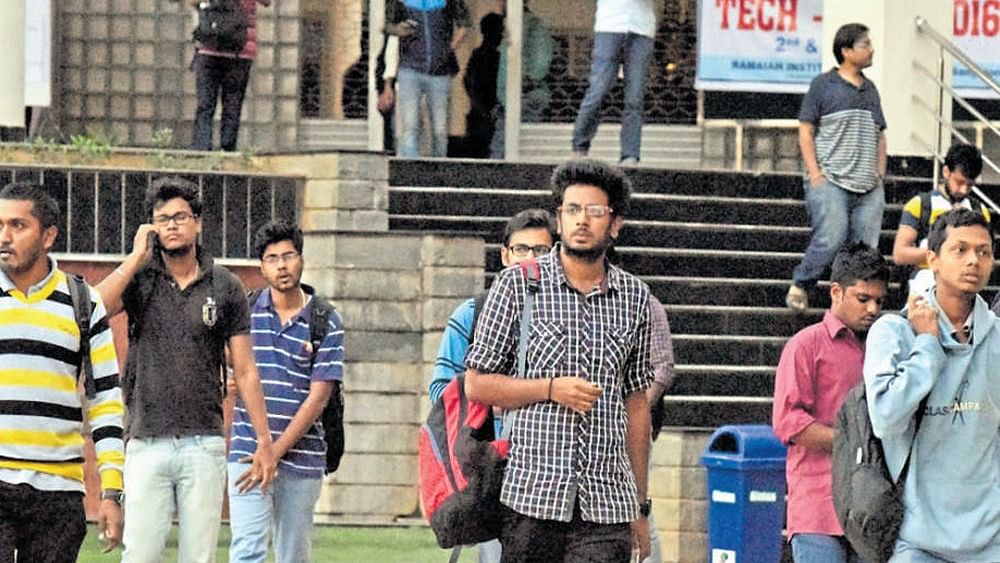
A representative image of students in a college campus.
Credit: DH File Photo
The universities funded and regulated by the Government of Karnataka, which should have scaled new heights year after year, are now on a downward trajectory. It is noteworthy that the Minister for School Education and Literacy has openly admitted that Kuvempu University is in the “intensive care unit” (The Hindu, Sept 3). In reality, it is not alone—all the other universities are also in critical condition. One of the most pressing issues is the acute shortage of permanent faculty. Operating universities with temporary teachers appears to have become a permanent arrangement and a new model of university management in Karnataka.
The severity of the problem created by the lack of recruitment of teachers over the years is unimaginable. As universities failed to fill vacancies as they arose, the number of permanent positions decreased while the number of part-time or temporary positions increased, reaching alarming levels. The proportion of temporary teachers varies by university, but overall, about 60–70% of teachers hold temporary positions. For example, in the University of Mysore, as pointed out by the former director of the National Assessment and Accreditation Council, Ranganath, out of 71 sanctioned professor posts, 66 are vacant. The vacancies for associate and assistant professors were 87 and 116, respectively , as of August last year. The day is not far off when all the professor posts will be vacant at the University of Mysore, and that will be a sad day in the history of education in Karnataka. This is the plight of the state’s oldest university, which has a history of over a hundred years. The situation in newly established universities is worse. Many departments in older universities have no permanent faculty. Additionally, new courses introduced by universities lack sanctioned posts and are handled exclusively by guest lecturers.
Effect on Teaching and Research
The current recruitment system has significantly impacted both teaching and research. The quality of teaching has deteriorated, and students are deprived of the opportunity to learn from eminent scholars. Temporary teachers, who are poorly remunerated, often with irregular payments, are demotivated.
Both individual research by teachers and PhD guidance have suffered. With the increasing number of part-time or guest lecturers, the number of qualified guides has reduced drastically, and in the departments without any permanent faculty members, no guides are available. The research students of such departments are encouraged to find namesake guides outside the department or even outside the university, which is a very strange situation. In the departments that have one or two qualified guides, irrespective of the guide’s area of specialisation, a large number of students are assigned, flouting the university regulation regarding the number of research students to be assigned to a guide at a time. On the whole, the atmosphere in the universities is not conducive to meaningful teaching and research, and our universities have failed to discharge their basic duties.
Why is there such a deterioration in our universities? The main reason is resource crunch. Successive governments in Karnataka have shown great enthusiasm for starting new universities but not for funding them adequately. Budgetary allocations for the education sector itself being very inadequate, the available limited resources for higher education are thinly distributed among a large number of universities, and no university gets adequate funds. It is very disturbing to note that in Karnataka, public expenditure on education, which amounted to 15.6% of the aggregate public expenditure in 2010-11, came down to 10.2% in 2023-24 (Budget Estimate), according to the Reserve Bank of India Report on State Finances, 2023.
The focus of the government is on saving expenditure on salaries in the universities rather than meeting the basic requirements. The universities are not permitted to fill up the vacancies because if permanent teachers are recruited, they will have to be paid as per the University Grants Commission’s scales of pay, and that will increase the expenditure on salaries, and the salary grants of the government will have to be increased. To avoid the increase in salary grants, the universities are compelled to manage with an unusually large number of temporary teachers, with a catastrophic effect on the entire university system. Incalculable damage to the university system has already been done, and it is no exaggeration to say that the universities are on the brink of an unprecedented crisis. It is time that the authorities realise that it is their duty to run the universities on sound lines and initiate the necessary corrective measures at the earliest to rejuvenate all the universities and to ensure that the older universities return to their past glory.
(The writer is a former Professor of Economics at the University of Mysore)